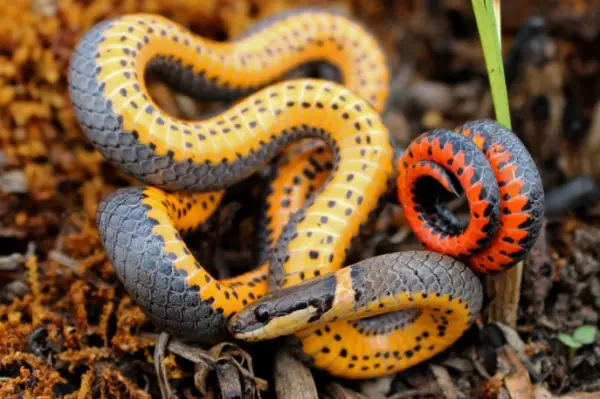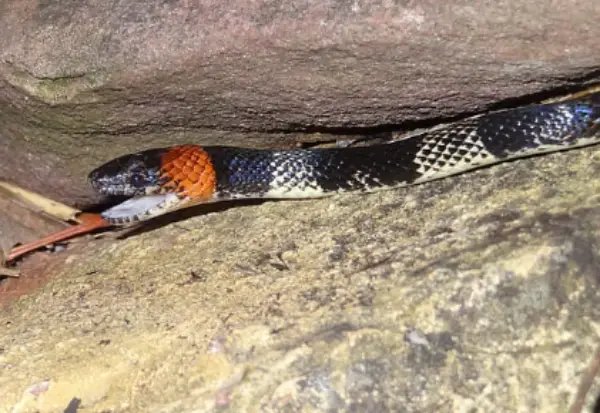Some snakes reach terrifying lengths, and the more prominent they are, the more fascinating they become to humans. The lack of limbs, the ability of some snakes’ poison to kill a grown man, and their generally cold-blooded nature have always attracted humans.
Giant, potentially lethal snakes like this are the most sought-after by zoos. Meanwhile, there are hundreds of snake species whose members lead quiet, unremarkable lives, some of them barely lasting as long as an earthworm. This article will discuss the smallest venomous snakes in the world. Let’s dive in now!
7 Smallest Venomous Snakes in the World
1. Black-banded Sea Krait
| Scientific Name | Laticauda semifasciata |
| Size | 75-128 cm |
| Location | western Pacific Ocean |
| Diet | Eels and small fish |
This type of sea snake is often seen near coral reefs. It has a bulky body and no neck to speak of, in addition to a short head. There are no bony outgrowths from the spinal column that support the tail.
Thus, it is only a flap of skin fanned out like a fin. The abdomen is relatively spacious. It congregates near the coast and reproduces in caves and tiny reef crevices.
It is typically only spotted at night and never during the day. Since it needs to come up for air at least once every six hours, this is when we expect to see it.
Even though banded sea kraits have some of the most potent venoms in the animal kingdom, they are incredibly docile and reluctant to harm humans.
The banded sea krait’s neurotoxic venom makes it one of the most lethal species in our oceans, and its venom is ten times stronger than that of a rattlesnake.
The venom targets the victim’s neurological system, causing convulsions, paralysis, heart failure, and even death. Each krait has the ability to produce 10 – 15mg of venom.
Only a small portion of the amount produced is fatal, but this species is exceedingly docile, non-aggressive, and does not attack unless in self-defense.
2. Leaf-scaled Sea Snake
| Scientific Name | Aipysurus foliosquama |
| Size | Can grow up to 90 cm |
| Location | Western Australia |
| Diet | Small fish and fish eggs |
The length is reportedly close to 800 mm, and the color is deep purple-brown. A little-understood species, this fish hunts for wrasse and gudgeon in coral caves and fissures for food.
The leaf-scaled sea snake (Aipysurus foliosquama) is a venomous sea snake from the family Elapidae. It was once assumed to be extinct on Australia’s Ashmore and Cartier Islands, where it was endemic.
3. Ringneck Snake

| Scientific Name | Diadophis punctatus |
| Size | 22.86-38.1 cm |
| Location | North America, from southern Canada down to Mexico |
| Diet | Earthworms, slugs, and salamanders will also eat small snakes and lizards |
Ringneck snakes are venomous snakes. The venom of these snakes are very mild and not effective to humans. This nocturnal snake, native to the Americas, derives its name from the bright yellow, red, or orange-yellow band that often appears around its neck.
The remainder of the snake might be any shade between olive green and blue-gray, brown and charcoal.
Approximately 14 subspecies of this snake are recognized by herpetologists. They’re all roughly the same length (around 9.8 inches). The exception is the slightly longer royal ring-necked snake.
The ringneck snake is the only venomous species of snake mentioned here, and its venom is strong enough to kill its prey.
Not only lizards and baby snakes of other species but also frogs, salamanders, slugs, and earthworms fall into this category.
The ringneck snake is harmless to humans due to its small, retracted fangs. The snake’s anal vent, which is brilliant red, is exposed when it feels threatened, and the tail curls up.
4. Stiletto Snake
| Scientific Name | Atractaspis bibronii |
| Size | 35-70 cm |
| Location | Sub-Saharan Africa |
| Diet | Small mammals, lizards, and other snakes. |
The venomous snake Atractaspis bibronii belongs to the family Atractaspididae. No recognized subspecies exist at this time. These animals can only be found in Africa.
The dorsal surface is a uniform dark grey, brown, or black. The underbelly is white or light yellow throughout and covered in shady spots.
Specimens with a more golden belly color may also have two or three rows of scales on each flank that match the belly coloration.
5. Small-scaled Burrowing Asp
| Scientific Name | Atractaspis microlepidota |
| Size | 45-75 cm |
| Location | Africa and the Middle East, including Kenya, Tanzania, Uganda, Sudan, Ethiopia, Somalia, and Saudi Arabia |
| Diet | Small rodents, such as mice and shrews |
The black coloration of Atractaspis microlepidota is “flatter” and lighter on the ventral (belly) side than it is on the dorsal (back) side. It has a broad, blunt nose and a flattened head.
Atractaspis has a short tail and a vaguely defined neck. Smooth scales cover the body. One notable distinction between Atractaspis and Viperidae is that the former has plates covering its head rather than small scales.
Some can reach 30 inches (75 cm) in length, although the norm is around 18 inches (45 cm).
Atractaspis microlepidota venom is not highly deadly to humans but has killed infants and toddlers on rare occasions.
6. Eastern Coral Snake

| Scientific Name | Micrurus fulvius |
| Size | Up to 46-76 cm |
| Location | Southeastern United States, including parts of Florida, Georgia, South Carolina, North Carolina, Alabama, Mississippi, Louisiana, and Texas |
| Diet | Small snakes, including other species of coral snakes, lizards, and small rodents |
Fif rows of smooth scales cover the dorsal surface at the animal’s midsection. There is a split in the anal plate.
Males have 197–217 ventral scales, and females have 219–233. Males have 30-37 subcaudals, and females have 40-47.
This snake often has a black muzzle and black eyes, with a yellow stripe across its head. The head is entirely black from the rostral scale to the back of the head.
The coloring is a sequence of concentric rings around the entire body, with wider red and black bands split by thinner yellow rings.
The red circles often have black specks within them. Fulvius’s venom is deadly because of its high content of PLA2 and relatively low content of low molecular mass components.
7. Sharp-nosed Pit Viper
| Scientific Name | Deinagkistrodon acutus |
| Size | Up to 1 m |
| Location | Asia, including China and Taiwan. |
| Diet | Small mammals, birds, and reptiles. |
The back of a Deinagkistrodon acutus is a pale brown or grayish brown, and on either side is a triangular pattern of dark brown.
About 20 light brown square spots appear on the back where the pointy tops of the two opposed triangles meet at the midline.
Large, dark patches run horizontally along both sides, just above the abdominal button. A black stripe runs from the corner of the eye to the corner of the mouth, and the top and upper sides of the head are also black.
The underside of D. acutus is golden brown with dark brown spots. The young are much paler than the adults, but the overall pattern is the same.
There has an upturned snout and a huge, triangular head. The physique is thick all around. The tail is short and ends in a sharp, cornified point that is slightly curled.
Nine enormous shields cover the top of the head. The keels of the dorsal scales are deep and tubercular. Most of the subcaudals are paired off, whereas a few of the anterior ones are alone.
Venom is very hemorrhagic, as the US Armed Forces Pest Management Board stated. At least four hemorrhagins (Acutolysin A, B, C, and D) can be found in the venom. Extreme pain and blood at the bite site are common early signs.
Conclusion
In conclusion, the diversity and adaptability of snakes are best illustrated by the seven smallest venomous snakes in the world. Some smallest venomous snakes are dangerous to people, but they serve essential roles in their ecosystems as predators and prey.
Precautions should be taken to avoid potentially dangerous encounters with these animals while showing the respect and appreciation they deserve.
Here, we conclude our article on “7 Smallest Venomous Snakes in the World (2023)” We hope you like our post. We will be back with another exciting article. Till then, stay tuned with us.
References:
- Wikipedia
- 9 of the worlds deadliest snakes by britannica.com
- 10 of the deadliest snakes by Livescience
- 10 Most Venomous Snakes In The World by Travelearth
Also Read:

A writer who studied agriculture. Nature has always drawn me in, and my main goal in writing about it is to discover some of its secrets. You can usually find me reading Bengali and English masterpieces or filling the room with lovely music if I’m not engrossed in nature or anime material. I adore playing the guitar. I’m also that friend of yours who enjoys playing video games.
